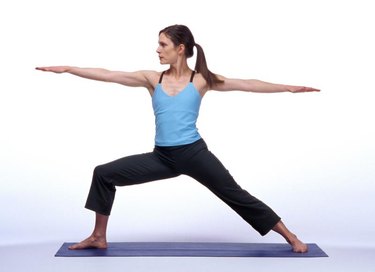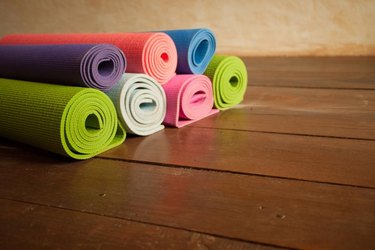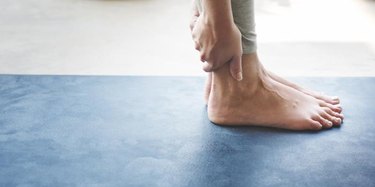
You take the courageous effort of entering a yoga studio and laying out a yoga mat — either one you found tucked away in your closet or one you borrowed. You sit down and wait for class to start. But, then it dawns on you as others come in and lay their mats out in a particular manner — you don't even know if you put the mat face up or down?
It's almost like the nightmare of wearing your clothes backward or putting on two different shoes. Not knowing the right way to lay your mat makes you look like the yoga novice you are. Using the wrong side of the mat can have very real implications for your practice, too. Instead of offering a sticky surface on which you find a grip, you'll end up sliding into postures you never intended to do.
Video of the Day
Video of the Day
A few clues tell you which side is "up" when it comes to a mat. If you've got a brand new mat, know that it might have a bit of slip — even if you choose the right side — due to the preservatives it's coated with to keep it from deteriorating on the shelf. A good spritz with essential oils, white vinegar and water and several uses will wear it in.
Read More: Easy Ways to Fix a Slippery Yoga Mat
Nubbier Side
Most sticky mats feature small nubs in the texture that are designed to hold you in place as you balance in Tree and Crescent Lunge, among other poses. This is the side that should face your feet. But, these bumps are usually only on mats made of PVC, a vinyl-like substance. Most mats you encounter are made from this material, but if you choose a one made from a natural material, such as jute or cotton, you'll have to rely on another hint as to the face-up side.

If both sides of your mat are bumpy, look for the one with more pronounced bumps, as this is likely the side that should be face up.
The exception to this rule are mats that feature a microfiber, towel-like side and a classic nubby, rubbery side. These are designed to be practiced on with the towel-side up — you might need to squirt it with some water to initiate the grip. If you put it towel side down on anything but carpet, you'll slide and the mat will stretch uncontrollably as you practice. You might select such a mat for a hot yoga class.
Shinier Side
Some yoga mats made from a combination of polyurethane, rubber and latex don't feature nubs — the material itself is grippy. Usually, these mats have a shinier side that should face up for practice.
Some companies, Lululemon, for example, offer a reversible mat that's usable on either side, depending on your practice. One offers more sweat-wicking capabilities for a hot class and the other a little more comfort for a gentler session. You can ask the salesperson or just experiment with the side you prefer for your style of practice.

Side with the Logo or Tag
If you've got a name-brand yoga mat, look for the label or logo to indicate the side that should face up. Usually, it's a little square of fabric or a stamp placed in a corner of the mat.
Other yoga mats have a bright design or pattern on the surface that shows which side should face up.
Worn Side
When you borrow a mat from a studio, it's probably not the mat's first time. Look at the surface of the mat and you may notice worn sections where people's feet and hands have rubbed. This "wear" tells you which side is going to be best face up and provide you with a grip.
Read More: What Makes a Good Yoga Mat?